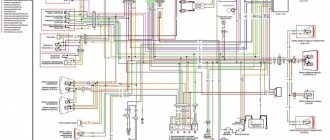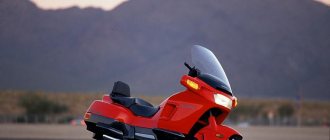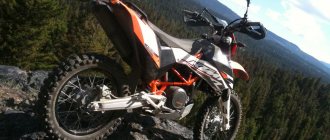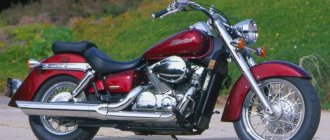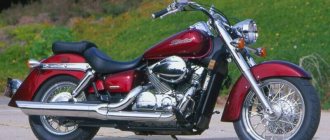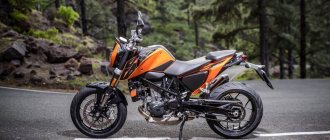Which motorcycle is the favorite of all beginners who are partial to sports motorcycles. Of course, Kawasaki ZZR 400! Strictly speaking, this is not a sportbike, but a sport-tourist, but who cares? The main thing is that it is beautiful, big and fast enough to take off at a speed sufficient to enter low-Earth orbit. At least that’s what it seems to novice motorcyclists, who are the main target audience for this model. But this motorcycle is really quite good, which, combined with an affordable price on the secondary market, makes it very popular to this day.
000_moto_0211_040
Kawasaki ZZ-R400: sports tourer, 1990–1997, 398 cm³, 53 hp, 197 kg, 80,000–180,000 rub.
Kawasaki ZZ-R400: sports tourer, 1990–1997, 398 cm³, 53 hp, 197 kg, 80,000–180,000 rub.
STORY. Sales of the Kawasaki ZZ-R400 motorcycle started in 1990, and in the company’s model range it replaced the obsolete GPZ400R, which had been produced since 1985. The sports touring motorcycle was created for the Japanese domestic market, as an analogue of the “six hundred cc” version for Europe. From this followed the main advantage of the “Zizer” over all its “classmates”: full size. Other “four hundred” cars were developed from scratch specifically for short Japanese people, and the ZZ-R400 differed from its “European” brother only in its reduced engine capacity. The suspension, fairings, controls and frame were taken from the 600. Hence the incredible popularity of the device on the second-hand market in Russia. Not a single one offered “so much motorcycle” for quite modest money. The motorcycle remained in production for 16 years, almost unchanged, and since 2010 its place on the domestic market was taken by the Ninja 400R, a four-hundred-cc analogue of the well-known ER6-f.
Main competitors
- The Suzuki RF 400, produced from 1993 to 2000, is one of the most common competitors of the Zizer. These two models are almost identical in specifications, and both have their pros and cons. However, the ZZR 400 is much more common, which can undoubtedly be considered one of its advantages. If the RF 400 needs repairs, you are unlikely to find spare parts in stock.
- Honda VFR 400, in different versions and under different names (RVF 400) produced from 1986 to 2001. The first generation of this motorcycle can boast of terrifying acceleration dynamics, which sets it apart from other 400 cc sports tourers. However, due to its advanced age, finding such a copy in good condition is quite problematic, and the latest generation, produced since 1994, is comparable to the ZZR 400 in all respects.
004_moto_0211_040
2010 (Ninja 400R).
2010 (Ninja 400R).
Upgrade table
| Years of manufacture | Major design changes |
| 1990 | Model debut (ZZ-R400K). Engine power: 58 hp at 12,000 rpm, 36 Nm at 10,000 rpm. Dry weight 195 kg. |
| 1993 | Modification ZZ-R400N (better known as ZZ-R400-II). Power reduced to 53 hp. at 11,000 rpm, torque - 37 Nm at 9,000 rpm. The wheelbase has been reduced by 10 mm (to 1430 mm), dry weight has increased by 2 kg (to 197 kg). Inertial charging appeared, the shape of the “plastic” was changed, and a fuel gauge appeared on the dashboard. |
| 1997 | Instead of a second daily odometer, there is an electronic clock in the tachometer housing. Rear shock absorber with adjustable spring preload and rebound force. |
| 2001 | An exhaust gas afterburning system (KLEEN) appears in the exhaust system. |
FOR WHAT? “Zizer” is a sports touring motorcycle designed specifically for beginner Japanese motorcyclists. Its character is soft and flexible, but unlike its competitors, the ZZ-R is a “big” motorcycle. It was this fact that brought the “Zizer” to the top of popularity in Russia, because prices for the ZZ-R400 on the secondary market were slightly higher than for “naked” classics like the Honda CB400 Super Four or Suzuki Bandit 400, but the ZZ-R offered quite “ human" comfort behind the wheel, and it looked like a real sportbike. In this regard, Zizer simply had no competitors in its price category. The motorcycle, the design of which was developed in the late 80s, turned out to be so successful that even now it does not look like a complete anachronism. Probably, partly for this reason, the ZZ-R400 does not lose its popularity. Perhaps the main mistake (and a very serious one) of beginners, and they are the main “consumers” of the ZZ-R, is that they perceive the motorcycle as a “plastic rocket” - a real sportbike, which the “Zizer” is not. It is precisely this attitude towards a motorcycle and riding “for all the money” that leads to sad consequences and the spread of the opinion “zizer” is trash,” which is actually unfair.
Technical characteristics and parameters.
The reason why the Zizer is still so popular lies on the surface - for a modest amount the buyer gets a really peppy motorcycle. Its liquid-cooled 4-cylinder engine is a little weak at low end, but delivers excellent performance at mid to high revs. And in general, the technical characteristics of the Kawasaki ZZR 400 fully correspond to its class - it is a nimble and at the same time very comfortable sports tourer. At the same time, the maximum speed of the Kawasaki ZZR 400 is 190 km/h, if, of course, the motorcycle is in good technical condition. Another thing is that in this mode it will empty the gas tank dry in 130-140 kilometers, if not less.
The bike has a 6-speed transmission, and the first two gears are quite short, so you will have to shift frequently, especially when driving around the city. This has a plus - the Kawasaki ZZR 400 motorcycle can be an excellent “study desk” for a novice biker. He is obedient and flexible enough so as not to provoke a beginner into dangerous road experiments, but with skillful handling he is capable of delivering such a dose of adrenaline that it will definitely not seem too much. This is where its main advantage lies - balance.
007_moto_0211_040
The brakes on the ZZ-R400 were carried over from the 600, so their efficiency is in perfect order.
The brakes on the ZZ-R400 were carried over from the 600, so their efficiency is in perfect order.
WHERE AND HOW TO SEARCH? In general, the design of the motorcycle is very reliable. There are no serious “diseases” in any components of the motorcycle, and all the problems that are often discussed when discussing the model are associated with inept operation of the motorcycle or misuse. The first and main advice when choosing a Zizer: look for a motorcycle “without mileage in the Russian Federation.” (takeaway) In the vast majority of cases, the ZZ-R400 is bought by compatriots as the first Japanese motorcycle, respectively, either after experience in operating domestic equipment, or without experience at all. As a rule, beginners have little knowledge in the field of proper maintenance and insufficient operating experience. And it is in the process of “learning” that motorcycles are “killed” literally within a season or two of living in Russia. The chance of finding a device in decent condition from those that have been with us for at least a couple of seasons is quite difficult. However, we should not forget that a device freshly imported from Japan can turn out to be a well-made-up “dead man,” although there are still not many of them.
When choosing a ZZ-R, you should not focus on devices from the first years of production. Even with the most careful operation, the gearbox resource is exhausted by 50–60 thousand km, and the engine becomes noticeably “tired” by this mileage. Motorcycles produced in the early to mid-90s (either in showrooms or through private advertisements) traditionally show no more than 25 thousand km on odometers - “a fresh addition, but hard to believe.”
Tuning and modification of a plastic Japanese samurai.
The Kawasaki ZZR 400 has very decent technical characteristics, so owners often pay attention to improving the aesthetic side of their motorcycles - stickers and so on. However, installing a direct-flow muffler instead of the standard system is also popular, since the sound of the Kawasaki ZZR leaves much to be desired - a kind of inexpressive squeal. But with an aftermarket exhaust like the Acrapovic or Two Brothers, the ZZR 400's sound changes dramatically. There are also options for replacing some transmission elements with reinforced ones, which eliminates the problem with second gear, which sooner or later inevitably arises on all Zizers. True, the set of parts required for this operation costs a lot, so most owners leave everything as is. So most often in the case of the Kawasaki ZZR 400, tuning comes down to replacing the exhaust with a louder one and pasting the motorcycle with different stickers. Sometimes the suspensions are changed to more modern ones, but this solution also cannot be classified as a budget solution.
011_moto_0211_040
The speedometer “up to 260” indicates that the device is “not original”.
The speedometer “up to 260” indicates that the device is “not original”.
So, the device from 2000–2004, just imported from Japan, can be considered optimal in terms of price-quality ratio. It will cost an average of 130–170 thousand rubles. There is no point in buying newer devices from an economic point of view: for 200 thousand rubles. you can choose a much more cubic capacity apparatus.
Considering that, as a rule, “four hundred” cars do not stay in the same hands for more than a couple of seasons, we can safely talk about the high liquidity of this type of equipment. There is always a demand for entry-level motorcycles among the “younger generation”, and regardless of the condition of the motorcycle, it will be easy to sell it, although the amount that can be earned for a “running” device will directly depend on its condition. If during a year or two of operation the ZZ-R rarely encountered asphalt, did not participate in “street racing” and was well maintained, it will lose no more than 15–20% in price. When selling, however, it is worth considering that in recent years, entry-level equipment has shown a noticeable tendency to outflow to the regions. So, perhaps, it will be much easier to sell the “zizer” if you place advertisements in regional information resources on an equal basis with the central ones.
WHAT TO WATCH?
(-) A “crunchy” second gear while driving or a “jumping out” second gear is not a “family disease”, but a consequence of an overly zealous driving style in a vehicle that is calm in nature and purpose. Second gear is the heaviest gear on any motorcycle, as the difference between the gear ratios of first and second is greater than between any other adjacent gears, and the first-second pair is used most often, especially in urban traffic. Due to the difference in gear ratios and, as a consequence, the difference in the rotation speeds of the primary and secondary shafts, the second one is engaged with a noticeable shock load on the fork, the drive shaft and the gears themselves, which is why it becomes unusable after 40–50 thousand kilometers. All motorcycles are susceptible to this “disease”, especially “400” ones; it’s just that in the “Zizer” the unit itself has a slightly smaller margin of safety, which is why it fails faster than, for example, in a Honda.
The malfunction is diagnosed either on the move or while standing still - while holding the brake on the motorcycle, you need to engage second gear and smoothly release the clutch. If the motorcycle stalls, most likely everything is in order with the gearbox, otherwise the gear will simply “jump” into neutral. Overhauling the gearbox along with spare parts will cost approximately 25–30 thousand rubles, and, in addition, is a signal that the motorcycle is “tired” and other components. In short, if you suspect a gearbox malfunction, you should refuse to purchase this copy.
(-) It is worth paying attention to the engine oil level , especially if the motorcycle is bought second-hand. Even short driving with insufficient oil level can “kill” the crankshaft. By the way, the general increased noise of the engine itself indicates that, most likely, it was not “fed” with the best oil, did not monitor its level and was not changed in a timely manner. So it’s better to refuse a “clattering” motorcycle, even if the plastic is in perfect condition and the engine runs smoothly. What “surprise” the motorcycle will present after purchase is unknown.
(-) The tight movement of the clutch lever indicates that the release cam located on the shaft shank has worn out. The part itself is inexpensive (see Parts Table), but you need to remember that to replace it you need to remove the engine cover, so you will have to order a new cover gasket with the new shaft.
(-) Unstable engine idle can be caused by several reasons. Overheating often warps the plastic of the air filter housing, most often on the right side, and a gap forms in it through which unpurified air enters the engine. As a result, there is a violation of mixture formation and rapid contamination of carburetors. To detect this defect, just look into the gap between the gas tank and the diagonal of the frame. If there is a gap in the airbox, it will most likely be visible. The malfunction can be easily fixed using sealant or even regular tape. Also, the “fistula” may be located at the joints of the airbox and the air ducts leading to the carburetors.
Photo gallery
Many reviews say that this is one of the most successful motorcycles from Kawasaki. Its design will give odds to many more modern models. We recommend that you look at our selection in order to appreciate its classic appearance.
009_moto_0211_040
The same problem can occur in the first generation.
But here the airbox itself is visible to the naked eye, which can also “leak” along the seams. The same problem can occur in the first generation. But here the airbox itself is visible to the naked eye, which can also “leak” along the seams.
(-) Another possible cause of “floating” idle is a malfunction of the relay regulator. Low voltage confuses the ignition control unit. True, this “jamb” may not come out immediately, but after the battery runs out without proper charging (usually after half an hour or an hour of engine operation, and this is immediately visible from the dim light of the headlight). The relay itself, as a rule, “gives up” when using a faulty battery. The operation of the charging system is checked simply: at engine speeds above 4000, the voltage at the battery terminals must be at least 14.5 V.
Always modern design Kawasaki ZZR
The exterior of this model, even taking into account the time that has passed since the creation of the motorcycle, is considered very fresh and ultra-modern .
And this is a full credit to the design department of KAWASAKI, who were able to look into the future and do the incredible - to foresee the fashion trends of sports motorcycles for decades to come.
The fairings are bulky and massive at the same time , and therefore allow you to capture the driver in their “embraces” to create ideal aerodynamic conditions.
After all, this is the only way to achieve a comfortable ride at high speeds.
The instrument panel is very simple and concise . It is presented in the form of ordinary numbers and arrows.
Nothing superfluous - a classic of the genre. To create a sporty ambience, a chrome-plated exhaust pipe and textured steel brake discs are used.
Although the huge mirrors look a little ridiculous in the general plan, which only spoils the harmonious integrity of the picture.
012_moto_0211_040
(+) Having sliders on a motorcycle is not just desirable, but vital. When a motorcycle falls, it is not only the plastic that suffers (even used ones are not cheap at all), but also the engine covers, which for this reason are in serious short supply even at large engine dismantling sites.
WHAT TO FOLLOW? The main thing is not to forget that the Zizer is not a sportbike. Do not try to set speed and acceleration records with it. The key to a long life of the engine and gearbox is smoothness and softness. A rather heavy machine with a phlegmatic engine is indeed not as playful as similar motorcycles from other companies, but the Zizer’s purpose is completely different than, for example, the no less popular Honda CB400SF. The ZZ-R is a car for traveling, that is, for smooth and uniform movement over long distances, and not a city “bullet gun”. You need to remember this constantly.
It is best to fill the engine with high-quality “synthetics”, monitor its level and change it at least once every 7-8 thousand kilometers. The model is not oil-guzzling, but a new device may well “eat up” the lubricant, and the sensitivity of the engine to its quantity has already been mentioned above.
WHAT TO BUY? If your motorcycle is not equipped with sliders, you should install them as soon as possible. The protection of the motorcycle in case of falls is very low. This is perhaps the only important recommendation. Otherwise, the depth and focus of tuning is determined only by the tastes and thickness of the owner’s wallet. Since the ZZ-R400 is completely similar to the 600 cc “European” in terms of dimensions and seats, you can find a lot of tuning for it, ranging from pannier systems and touring glasses to “gel” seats and other baubles of varying degrees of usefulness.
Estimated cost of spare parts for Kawasaki ZZ-R400
| Name | Original spare parts, rub. | Non-original spare parts, rub. |
| Repair kit for 2nd gear (gear, track shaft, fork, pan gasket) | 11500 | — |
| Clutch release shaft | 1500 | 1000 (used) |
| Voltage regulator relay | 6800 | 2000 (Chinese noname) |
| Front plastic (muzzle) | 26500 | 6000 (used) |
| Engine cover left. + gasket | 3900 | 1800 |
| Engine cover right + gasket | 6300 | 4000 |
| Sliders | — | 2600 (Crazy Iron) |
Spare parts, mostly available in stock.
Spare parts are sometimes in stock.
Spare parts, mainly imported to order.
COMPETITORS.
General description of the motorcycle
Today, the Kawasaki ZZR 400 motorcycle seems somewhat ordinary and traditional.
But at the time of its creation, such a model was simply amazing.
And this is not only in terms of the design of the vehicle, but also its technical parameters, which were also excellent.
The motorcycle has a powerful sports bike frame made of aluminum alloy, as well as a four-cylinder engine with a liquid cooling system.
The perfect complement to everything else is a massive rear swingarm, disc brakes, a huge fuel tank, as well as a unique design, which until now is considered modern and impressive.
Comfort
The bike is not designed for two, but physically a passenger will fit. However, if you initially plan to buy a bike to transport someone, you should take a closer look at other options and classes. This model will be comfortable and safe to ride alone.
The convenience of the car also depends on how much its maintenance costs. Yes, spare parts are not easy to get, but it is possible.
But at the same time, the bike rarely breaks down, which can be heard more than once in one review or another. In order for the machine to last longer, it is important to promptly check all components and parts, and monitor the cleanliness, temperature and humidity where the bike is stored.
Let's start with the fact that I bought an old Japanese car, created only for the domestic Japanese market. Before this, I had never owned a motorcycle and knew practically nothing. I will describe the difficulties and share my accumulated experience. This is what my first post will be devoted to.
I purchased my motorcycle in February 2014. Terrible technical condition: snotty fork seals, dead rear shock absorbers, torn seat, bald tires, non-working rear brake, broken plastic, dangling instrument panel, different brightness of the light bulbs in the instrument panel, a short left turn, a piece of rusty metal on the brake machine instead of a normal cover, a stuck button emergency lights, this is just a first impression. But I was pleased with the price of 60,000 rubles. and the seller are familiar with the driving school person. I registered it and arrived under my own power. Another problem was discovered immediately after registration - I couldn’t secure the number. I took a roundabout path to the garage. Since the motorcycle is rare, it is impossible to find any documentation. In order to somehow understand its structure, I started looking for online stores with spare parts catalogues, and downloaded pictures to my phone. In February you can’t really travel around Tula, so I read forums during the day, and in the evenings after work I took it apart, studied it, and repaired it. The first step was to reupholster the seat. A trifle, but how it affects the appearance. I soldered the plastic in an atypical way for motorcyclists, but familiar to motorists - soldering metal mesh with a hair dryer, and also soldered the body of the instrument panel. The failure with the number-matching mount was due to the lack of an original element of the rear wing, instead of which there was some kind of universal bracket, this became clear from the picture from the spare parts catalog. I bought a used fender with headlight. From then on, the number proudly took its place.
Then there was a lot of small work, such as: new identical incandescent light bulbs instead of different LED ones in the tidy; dismantling Chinese xenon; the motorcycle was equipped with an alarm, but did not respond to it; in the feedback control panel, the antenna contact had fallen off; the motorcycle was set to security, but when it screamed it didn’t blink at all, I bought 2 diodes on the market and soldered them to the rear turn signals; checked all the fuses and inserted them, the ratings are as indicated on the block cover; I had to remove the left control panel, where the front turn signals are, cut the cover and cut out a piece of the left turn wiring - due to a short circuit, two wires sintered through the braid; removed the tank, unscrewed the tap and drained the sediment; changed the insides of the rear brake cylinder; installed a new brake cover and new parts under it; I machined a duplicate key from the original new blank, replaced the seals in the fork; I disassembled, cleaned and lubricated the hazard warning button. I removed the carburetors for disassembly and cleaning. I saw that the gas cables would soon fray. Ordered, they came. Not the same at all. According to the catalogue, they are not mine. Here I was in a wild stupor. I went to Moscow, rummaged through a box of non-original cables, found a Honda one of suitable length and installed it. As it turned out, I had a non-original right remote control, I learned this from looking at a bunch of photos of the ZRX group on the social network. Disassembling the ZZR 400-2 came to my rescue. And before that there were forums and a spare parts catalog with two rows of open tabs ZZR400 1996 and ZRX400 1996, where it was necessary to compare the articles. In general, I had to find out the history of the ZZR400. After all, there are two generations, the second one seems to have started in 1993. With the second generation we have several identical parts, but more on that a little later. The first generation remote control also had a switch, while the second had only 2 buttons - emergency engine stop and starter. The ZRX has two models, 400 and II, the only differences being the fairing and headlight shape. By this time I had already started riding my motorcycle. I found out that it needs to be serviced according to the ZZR600 manual. How to maintain and repair on the TV show “Motogarage” (Drive - Tele). From the spare parts catalog, I found out what tools Kawasaki equips its motorcycles with and bought analogues at a car store so as not to remain immobilized somewhere on the track.
I studied short wiring. I found such a jumper. The search for a new one was unsuccessful, so it was decorated with black electrical tape.
I made a homemade hydraulic synchronizer from droppers, but the design is not viable. Synchronization must be done on a warm engine, this causes the tube to become very soft and further compresses it under vacuum. They are also very thin and absorb quickly. Therefore, version 2 was made. More serious. For normal synchronization, compression should be normal and without strong run-up. Carburetor adjustment is carried out so that the same QUALITY fuel-air mixture is supplied to the cylinders from the carbs (quality screws). Synchronization is done in order to adjust the QUANTITY of the mixture. If the quality screws have been touched, then synchronization must be done. Usually after cleaning, when all the jets and screws are removed. It's better not to go in there yourself. Quality screws are ideally adjusted using a gas analyzer. But no one has it, so there are these instructions: 1) Warm up the engine; 2) tighten the screws completely; 3) unscrew 0.5-1 turn; 4) set the idle speed to 15% more than the normal value (1500 rpm); 5) using quality screws, we raise the speed to the most stable; 6) slightly lower the idle speed screw to (1500); 7) repeat step 5 and 6; Using the quality screw you achieve stable idle speeds of 1300+-50 rpm. Engine operation can be diagnosed by the condition of the spark plugs or by the jumping idle speed needle. White soot is a poor mixture, black is a rich mixture, ideally a brick color. Adjustable with quality screws. The manual says that all rubber bands in carburetors need to be changed every 5 years. This is of course crazy, but if you replace the rubber rings (O-rings) on quality screws, it will be easier to adjust. Over time, and even more so from gasoline, rubber becomes tanned and loses its properties. The synchronization screws must first be turned between the 3rd and 4th carburetors to align their operation. After turning the screw even the slightest, you need to pull the throttle. Only then can we move on to 1 and 2. And with the very last action we synchronize the pairs. Don't forget to gas it. For your motorcycle, look at the design of the synchronization mechanism on the carburetor itself. For me, the main one is the fourth one. The rest are configured relative to it.
Synchronization must be done on a warm engine, this causes the tube to become very soft and further compresses it under vacuum. They are also very thin and absorb quickly. Therefore, version 2 was made. More serious. For normal synchronization, compression should be normal and without strong run-up. Carburetor adjustment is carried out so that the same QUALITY fuel-air mixture is supplied to the cylinders from the carbs (quality screws). Synchronization is done in order to adjust the QUANTITY of the mixture. If the quality screws have been touched, then synchronization must be done. Usually after cleaning, when all the jets and screws are removed. It's better not to go in there yourself. Quality screws are ideally adjusted using a gas analyzer. But no one has it, so there are these instructions: 1) Warm up the engine; 2) tighten the screws completely; 3) unscrew 0.5-1 turn; 4) set the idle speed to 15% more than the normal value (1500 rpm); 5) using quality screws, we raise the speed to the most stable; 6) slightly lower the idle speed screw to (1500); 7) repeat step 5 and 6; Using the quality screw you achieve stable idle speeds of 1300+-50 rpm. Engine operation can be diagnosed by the condition of the spark plugs or by the jumping idle speed needle. White soot is a poor mixture, black is a rich mixture, ideally a brick color. Adjustable with quality screws. The manual says that all rubber bands in carburetors need to be changed every 5 years. This is of course crazy, but if you replace the rubber rings (O-rings) on quality screws, it will be easier to adjust. Over time, and even more so from gasoline, rubber becomes tanned and loses its properties. The synchronization screws must first be turned between the 3rd and 4th carburetors to align their operation. After turning the screw even the slightest, you need to pull the throttle. Only then can we move on to 1 and 2. And with the very last action we synchronize the pairs. Don't forget to gas it. For your motorcycle, look at the design of the synchronization mechanism on the carburetor itself. For me, the main one is the fourth one. The rest are configured relative to it.
Periodically, the motorcycle would stall and start poorly when hot. I decided to check the ignition coils and made the device as indicated in the instructions for the ZZR600 motorcycle. The spark should be blue, not yellow and powerful. The check showed a bad spark on cylinder 3; it is necessary to trim the ends of the wires at the coils. Over time, the braid dried out and moisture got in. Watching the “Motogarage” program, I learned that it is necessary to use chemistry. There is a special spray for electrical wiring. The installed stars differed from the original ones in the number of teeth. And the chain became unusable, despite the inscriptions DID JAPAN, it was Chinese and a huge number of oil seals flew out of it. The decision was made to buy the original chain, albeit with an overpayment for delivery. Next was servicing the rear shock absorbers. Thanks to the post bikepost.ru/blog/44170/VX-CAFE-ili-istorija-s-korotkim-prologom-i-nezakonchennym-epilogom-ot-tom-kak-ja-sobiral-sebe-bajk—CHast-IV.html but he left the old cuff. Indiscriminately, I ordered cuffs at random. They arrived in the original size, one-to-one, just right. www.racetech.com/HTML_FILES/SKDS-Shock%20Shaft%20seals.html SKOS 125 - SK OIL SEAL KYB 12.5x27x5 Communicating with them via email through Google translator, I realized that I can’t limit myself to communicating in Russia. Having received the parcel, I began to analyze it. And for good reason. There was no oil in the right shock absorber, and there was a little slurry in the left one, dirtier than water in a puddle. It's time to check the valves. A torque wrench with a torque of 5-25 Hm was purchased. Probes with 5 micron pitch and micrometer. There is nothing to do without them. Universal shim calculator program All my valves were clamped. After adjusting the valves, it is imperative to synchronize the carburetors. After a while, a trip to Lipetsk from Tula and back in one day revealed wild gas consumption and ragged dynamics. Here I felt an acute lack of a detailed repair manual. The Internet didn’t help at all, but buying a book in Japanese cost 3,000 rubles. the hand does not rise. Even queries using Japanese search engines サービスマニュアルzrxII, searching by book article, did not help at all. I couldn't get the treasured book. On one of the Japanese forums I met Hiroyuki Akahori, we began to communicate via email in English through a translator. He gave me a link to the Kawasaki website where I could enter the year, model, and engine number of my motorcycle to get vital data that was not previously available. Google Chrome will happily translate this page. www.kawasaki-motors.com/service_data/cgi-bin/svsearch.cgi?mode=mc
Although the ZRX400 and ZZR400 are technically very similar, the idle speed, carburetor float levels and tire pressures are different. This is how I ended my season. And in winter I got into the engine. But more on that in the next post. I fix the motorcycle for myself, it’s my hobby, my Lego. I don't care about appearance, I care about its performance and reliability. They're like your favorite jeans, worn out but so comfortable.
Cherry blossoms by Hiroyuki Akahori.
What do the owners say?
Connoisseurs of retro classics speak positively about this bike. For many, it, like other representatives of the class, has become a replacement for road motorcycles. Indeed, this technique is perfect for urban conditions, because it is leisurely and measured in dynamics.
Judging by the reviews, the motorcycle leaves a pleasant impression with its smooth ride and characteristic sounds when the engine is turned on and running. Those who have previously ridden really old bikes, which are almost half a century old, say that they don’t feel much difference in the sensations.
In conclusion, it is worth noting that the Kawasaki W400 is an excellent example of how to properly make an antique motorcycle. The appropriate appearance and characteristics are combined with modern safety and comfort measures. So if you want to touch the retro classics, this is one of the best options.
